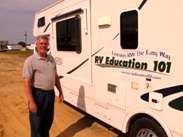He is a member of a regional RVing group in Rio de Janeiro State called “Amigos do Rio RV Group (Rio’s Friends) (Brazil)”. Over the last year Adauto has been researching and compiling free RV information for other RV enthusiasts in Brazil, since they do not have a bibliography about RVing in Brazil. He was working on a trailer sway article when he contacted me, to help educate some of the RVers in his group on sway issues. He wanted to know if I would be interested in working together with him on the article. At times it was a bit difficult to tranlate what each of us were saying to each other, but I think we figured it out.
This is part 1 of 2. I will publish part 2 of the article next week.
Trailer sway, that side-to-side fishtailing movement,
 occurs when there is a force perpendicular to the tow vehicle and trailer trajectory, applied to the hitch ball. An important factor in controlling sway is the amount of tongue weight applied to the hitch ball, and how that weight is distributed to the tires on the tow vehicle. A general rule is trailer tongue weight should be 10 to 15% of the fully loaded trailer weight, for trailers weighing over 2,000 pounds. If the tongue weight (what generates friction to the tow vehicle rear tires) is properly distributed to the rear tires of the tow vehicle most lateral forces encountered will not be sufficient to start sway. If the lateral forces do overcome the tire friction trailer sway will start.
occurs when there is a force perpendicular to the tow vehicle and trailer trajectory, applied to the hitch ball. An important factor in controlling sway is the amount of tongue weight applied to the hitch ball, and how that weight is distributed to the tires on the tow vehicle. A general rule is trailer tongue weight should be 10 to 15% of the fully loaded trailer weight, for trailers weighing over 2,000 pounds. If the tongue weight (what generates friction to the tow vehicle rear tires) is properly distributed to the rear tires of the tow vehicle most lateral forces encountered will not be sufficient to start sway. If the lateral forces do overcome the tire friction trailer sway will start.This would be a good time to include an analysis about tow vehicle and trailer traffic speed. As speed increases, tire traction decreases with a corresponding increase in the possibility of trailer sway. At 60 mph, and under wet road conditions, a weak lateral wind may start a lateral trailer displacement.
Natural trailer balance, when travelling, may be understood as a vertical pendulum, but in the opposite direction
 . The trailer sway is similar, but the displacement is horizontal, over the road, with the trailer (and the tow vehicle by consequence) going from one side to the other many times. If the trailers vertical stabilization, associated with the suspension, is working properly it helps in preventing small sways. Weight distribution bars reduce vertical displacements (swings) and transfers the hitch weight to the vehicle and trailer tires. This results in the rear tires gripping the road better, and may avoid these sideslips. So, it is important, before leaving on a trip, that we complete a checklist of all items associated with the tow vehicle and trailer stabilization. These checks would include inspecting items like tires, weight distributing bars, proper hitch adjustments, the trailer and tow vehicle suspension systems, and that all cargo is distributed evenly. If these items are not in a good shape, it will decrease the speed that we can safely travel at.
. The trailer sway is similar, but the displacement is horizontal, over the road, with the trailer (and the tow vehicle by consequence) going from one side to the other many times. If the trailers vertical stabilization, associated with the suspension, is working properly it helps in preventing small sways. Weight distribution bars reduce vertical displacements (swings) and transfers the hitch weight to the vehicle and trailer tires. This results in the rear tires gripping the road better, and may avoid these sideslips. So, it is important, before leaving on a trip, that we complete a checklist of all items associated with the tow vehicle and trailer stabilization. These checks would include inspecting items like tires, weight distributing bars, proper hitch adjustments, the trailer and tow vehicle suspension systems, and that all cargo is distributed evenly. If these items are not in a good shape, it will decrease the speed that we can safely travel at.The bigger the trailer is (taller and longer) increases the chance for sway. There are two reasons for this, an increase in weight and an increase in mass (the area that will receive lateral winds). Weight increase will augment the forces applied to the hitch ball, especially when traveling downhill, due to the gravity, acceleration and also in case of any vehicle brake activation. If there is any unbalanced item in the towing system, it may become sufficient to start sway. If the trailers lateral area is larger, the amount of forces due to lateral winds is also increased. These forces may destabilize the tow vehicle and trailer motion, increasing the chance for sway.
There is another very important item associated with sways, and that is the number of trailer axles. Compared to one axle, two trailer axles increases the number of wheels 100% over the ground, and by consequence the increased tires gripping the road decreases the chance for sway. Another peculiarity associated with one axle is the vertical motion (front-back direction, referred to as porpoising) associated with vehicle brake activation
 . In this situation the trailers front end will tend to push downward. This vertical downward motion enhances the tow vehicles back wheel traction, but decreases the front wheel traction, and the forces applied in the opposite direction (up) will reduce the tow vehicles rear wheels traction. Depending upon total weight balance, the tow vehicle and trailer may start a back or front sway and the tow vehicles front motion control will be compromised. It is well known that for both single and dual axle trailers, the larger the trailer is the more unstable it is when talking about porpoising. Proper hitch work can mitigate some of this from occuring.
. In this situation the trailers front end will tend to push downward. This vertical downward motion enhances the tow vehicles back wheel traction, but decreases the front wheel traction, and the forces applied in the opposite direction (up) will reduce the tow vehicles rear wheels traction. Depending upon total weight balance, the tow vehicle and trailer may start a back or front sway and the tow vehicles front motion control will be compromised. It is well known that for both single and dual axle trailers, the larger the trailer is the more unstable it is when talking about porpoising. Proper hitch work can mitigate some of this from occuring.Statistics prove that 5th wheel trailers are more stable and sways associated with them are seldom reported. Why? It is mainly because a more stable condition is obtained due to the 5th wheel hitch being positioned over and close to the towing vehicle rear axle. In the case of a 5th wheel, lateral forces do not affect it like a trailer that is hitched at the rear of the tow vehicle. The weight at the hitch position of a 5th wheel trailer is higher and over the axle, enhancing the tow vehicle traction on the road surface. But, when towing a 5a wheel, the driver must be more careful in descending an incline because the natural tendency will be for the weight of the trailer to push the towing vehicle.
Always keep in mind the towing vehicle has a maximum tow capacity and that you must compute total RV weights including, passengers, cargo, and fluids and fuel. Also keep in mind that any weight added to the tow vehicle takes the same amount of weight from the towing capacity.
The most important items associated with trailer sways are:
a) underinflated tires
b) improper weight distribution
c) improper hitch adjustments
d) no sway control
e) air pressure from transfer trucks passing
f) long downhill (descent)
g) lateral wind
h) towing speed
i) inadequate towing vehicle
j) overload conditions
k) hitch to tow vehicle rear axle distance
l) poor trailer design
m) Mismatched tow vehicle & trailer
n) Not completing trailer/tow vehicle checklist
This article was written by Jose Adauto de Souza & Mark Polk
Tune in next week for part 2 of the article when we discuss what you can do to help control trailer sway.
Happy Camping,
Mark Polk
RV Education 101
RV University
Copyright 2009 by Mark Polk owner of RV Education 101







No comments:
Post a Comment